
John Benbow was an English officer in the Royal Navy. He joined the navy aged 25 years, seeing action against Algerian pirates before leaving and joining the merchant navy where he traded until the Glorious Revolution of 1688, whereupon he returned to the Royal Navy and was commissioned.
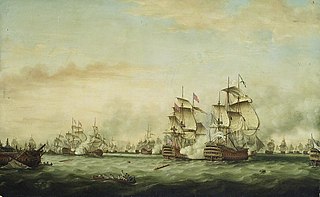
HMS Barfleur was a 90-gun second-rate ship of the line of the Royal Navy, designed by Sir Thomas Slade on the lines of the 100-gun ship Royal William, and launched at Chatham Dockyard on 30 July 1768, at a cost of £49,222. In about 1780, she had another eight guns added to her quarterdeck, making her a 98-gun ship; she possessed a crew of approximately 750. Her design class sisters were the Prince George, Princess Royal, and Formidable. She was a ship of long service and many battles.

HMS Royal Oak was a 74-gun third-rate ship of the line of the Royal Navy, built by Jonas Shish at Deptford and launched in 1674. She was one of only three Royal Navy ships to be equipped with the Rupertinoe naval gun. Life aboard her when cruising in the Mediterranean Sea in 1679 is described in the diary of Henry Teonge.

The action of August 1702 was a naval battle that took place from 19–25 August 1702 O.S. between an English squadron under Vice-Admiral John Benbow and a French under Admiral Jean du Casse, off Cape Santa Marta on the coast of present-day Colombia, South America, during the War of the Spanish Succession. Benbow vigorously attacked the French squadron, but the refusal of most of his captains to support the action allowed du Casse to escape. Benbow lost a leg during the engagement and died of illness about two months later. Two of the captains were convicted of cowardice and shot.
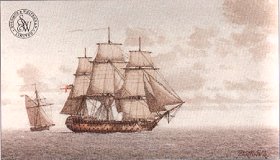
HMS Edgar was a 74-gun third-rate ship of the line of the Royal Navy, that saw service in the American Revolutionary, French Revolutionary and Napoleonic Wars. Launched in 1779, she fought in the battles of Cape St Vincent and Copenhagen, two of the major naval engagements of the wars.

HMS Cambridge was an 80-gun third-rate ship of the line of the Royal Navy, built at Deptford Dockyard to the draught specified by the 1745 Establishment as amended in 1750, and launched on 21 October 1755.
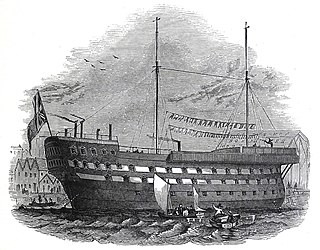
HMS Warrior was a 74-gun Alfred-class third-rate ship of the line of the Royal Navy, launched on 18 October 1781 at Portsmouth.

HMS Hero was a 74-gun third rate of the Royal Navy, launched on 18 August 1803 at Blackwall Yard.

HMS Prince was a 100-gun first rate ship of the line of the Royal Navy, built by Phineas Pett the Younger at Deptford Dockyard and launched in 1670.

The Foudroyant was an 80-gun ship of the line of the French Navy. She was later captured and served in the Royal Navy as the Third Rate HMS Foudroyant.
HMS Greenwich was a 54-gun fourth-rate ship of the line of the Royal Navy, built by Christopher Pett at Woolwich Dockyard and launched in 1666.
HMS Defiance was a 64-gun third rate ship of the line of the Royal Navy, built by Phineas Pett II at Chatham Dockyard, and launched in 1675.

HMS Oxford was a 54-gun fourth-rate ship of the line of the Royal Navy, built by Francis Baylie in Bristol and launched in June 1674. Her guns comprised twenty-two 24-pounders on the lower deck, with twenty-two large sakers (8-pounders) on the upper deck and ten smaller sakers (5-pounders) on the quarter deck.
Vice Admiral Francis Hosier (1673–1727) was a British naval officer. He was a lieutenant on Rooke's flagship at the Battle of Barfleur in 1693. He captured the Heureux off Cape Clear in 1710 and distinguished himself in action with the Spanish off Cartagena in 1711. He is chiefly remembered, however, for his role in the failure of the Blockade of Porto Bello, for which poor Government orders were largely responsible, during which he died of disease alongside thousands of his sailors.

HMS Lenox was a 70-gun third rate ship of the line of the Royal Navy, launched at Deptford Dockyard on 18 April 1678.
HMS Triumph was a 90-gun second rate ship of the line of the Royal Navy, launched at Chatham Dockyard on 2 March 1697. She was renamed HMS Prince in 1714.
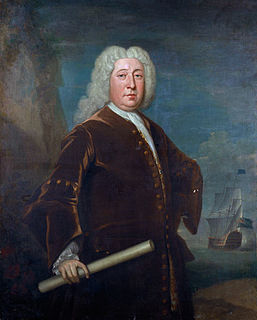
Sir George Walton was an officer in the Royal Navy during the late 17th and early 18th centuries, eventually rising to the rank of Admiral.
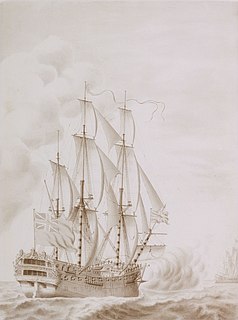
HMS Burford was a 70-gun third rate ship of the line of the Royal Navy, built at Deptford Dockyard to the 1719 Establishment, and launched on 19 July 1722. Burford was notably the early posting of both John Forbes and John Byng, both of whom rose to become Admirals.
HMS Tilbury was a 58-gun fourth rate ship of the line of the Royal Navy, ordered from Portsmouth Dockyard on 17 December 1742 to be built to the dimensions laid down in the 1741 proposals of the 1719 Establishment. She was launched on 20 July 1745.

HMS Dunkirk was a 60-gun fourth-rate ship of the line of the Royal Navy, built at Woolwich Dockyard to the draught specified by the 1745 Establishment as amended in 1750, and launched on 22 July 1754.














